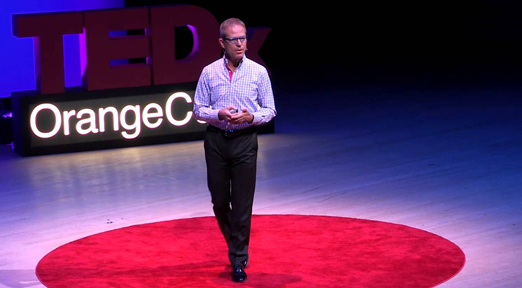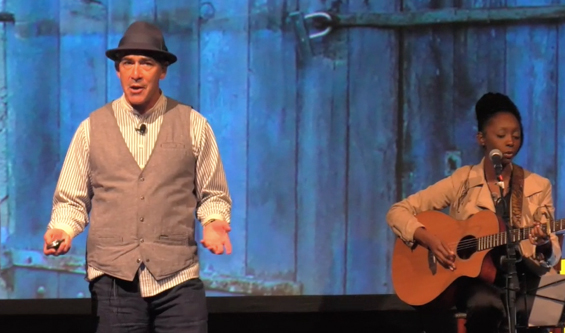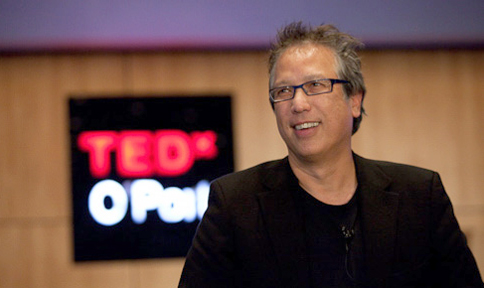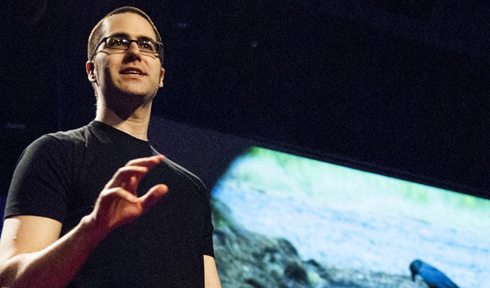
Harnessing the Power of Storytelling with Mitch Ditkoff
| Storytelling is one way to help people plumb the depths of who they are and make sense of what their lives are all about. | |
| |
 | You have written an extraordinary new book, Storytelling at Work, about how human beings capture each other’s attention and deliver a memorable message. Why is storytelling so important? |
 | Story is the simplest, most powerful, most universal way to deliver a meaningful, memorable message. It cuts through the clutter of information and data, and gets right to the heart of the matter. In today’s attention deficit disordered world it’s a challenge to communicate and really be heard -- to deliver the kind of communication that opens minds, sparks insight, connects people to their own innate wisdom, and inspires them to make a difference in the world. That's what storytelling is all about. It’s been going on for thousands of years and will continue to go on. It’s how we first communicate core values to our children – via fairy tales – and it’s how all of the world’s spiritual traditions communicate the essence of their teachings. Deconstruct any “holy book” and you will find that the DNA is story.
Information and data are not in short supply these days, but real meaning is. People hunger for meaning and for what exists beneath the surface of our lives. Storytelling is one way to help people plumb the depths of who they are and make sense of what their lives are all about. |
 | How can people become better communicators through storytelling? |
 | First, people can identify stories worth telling – narratives that have some kind of insight, value, or wisdom embedded within them that they want to communicate to others. Next, people can replace some of their other, less engaging forms of communication (i.e. case studies, slide shows, data dumps etc.) with story. By the way, everyone already knows how to tell stories. They’ve been doing it forever. It’s what psychologists call an “unconscious competency”. We know how to do it, but we don’t always know that we know how to do it. Practice, of course, helps along with having an audience that is willing to listen – whether it’s one person or a thousand. |
 | Does storytelling only apply to individuals, or can this type of influential communication also be used by organizations? |
 | Both. Individuals are telling stories, all the time, both on and off the job – our accounts of “what happened”. We tell them to our friends, our colleagues, our clients, and the press, because it’s a very effective way to transmit meaning and open up deeper levels of conversation.
Organizations can also tell stories. Indeed, the wise ones already do. It’s how they explain their service, their mission, vision, and values to the public. Some companies tell the stories of their early, entrepreneurial start up days because those stories are inspiring and communicate a lot of the company’s original DNA. Advertising and marketing are another form of storytelling, but sometimes those genres of communication inflate the truth or manipulate people into buying a product or service they neither want nor need. Finally, countries also use stories to communicate their value and their principles to the world in a memorable way. |
| Everyone in the world has wisdom inside them, not just the experts and great teachers. | |
| |
 | What is your definition of “wisdom sharing”? |
 | Let’s start first by defining “wisdom”. While there are lots of definitions out there, the one I like best is this: “the ability to perform an action with the highest degree of adequacy under any circumstance.” In other words, it’s truth in action – the ability to act in a way that is consistent with a deep insight, truth, or knowledge, which, by the way, gets right back to the name of our species. Literally translated, Homo sapiens means the “wise ones.” As a species, we may not always show it, but the potential is there – the potential to manifest a deep knowing and express it, through action, in the world.
The premise of my book is a simple one: that everyone in the world has wisdom inside them, not just the experts and great teachers. Everyone. This wisdom, however, is often unacknowledged or hidden, most often in our stories. Wisdom sharing is the communication of the deepest part of what we know with others, without preaching, evangelizing, or trying to convert. Stories, I have found, are the most humane and universal way to get this wisdom on the table. |
 | Who can benefit from reading Storytelling at Work and why? |
 | The book is aimed for anyone who has ever worked, works now, or will work. Part One of the book – 38 of my own “moments of truth” stories – are culled from the world of work which is often the last place anyone thinks that anything profound happens since we’re so focused on tasks and transactions. However, work is a very fertile ground for learning, growth, and experience -- especially when you consider how much time we spend there.
Wisdom is not just about going to church or temples. It’s not just about doing yoga or meditating. Wisdom is available to us every minute of the day. It is our birthright. So, I guess you might say the book is for anyone who wants to plumb the depths of what’s possible in their life, anyone who wants to elevate the conversation on planet earth, and be part of a community of forward thinking people who believe that it is possible for life to be lived more fully, if we would only open up and share what we really know with each other. |
| A 'culture of innovation' needs to be framed as not just another 'initiative' but the 'way we do business.' | |
| |
 | How can organizations foster a culture of innovation? |
 | There are thousands of ways an organization can foster a culture of innovation. If they are really committed to this noble venture, they will find their way. To begin with, its useful for an organization to conceive and communicate a compelling vision of what they are trying to accomplish, so that every member of their workforce will buy in and be intrinsically motivated.
Eliminating or decreasing fear is another key part of the equation. If people are afraid to fail or are going to be ridiculed for challenging the status quo, there cannot be a culture of innovation. Also, senior leaders need to be aligned about the need and walk the talk. Conversely, everyone in the company needs to own the effort – not just R&D or the folks sitting in the C suite. Above all though, a “culture of innovation” needs to be framed as not just another “initiative” but the “way we do business.” It is the sea that committed groups of aspiring innovators swim in, not an island they are swimming to. |
 | What are a few of the best innovation practices of leading organizations? |
 | Hire people who already care about innovation, so you don’t have to convince, cajole and persuade, which by the way, doesn’t work. Find a way to spark everyone’s intrinsic motivation and do what you can to match people to projects that truly fascinate them. Senior leaders and managers need to be more mindful of providing people the time and resources they need to conjure up new possibilities and then develop them. The dark side of innovation shows up when senior leaders ask people to be more creative, but don’t grant any more time and resources to develop the ideas that are generated. That just puts so much pressure on people.
Also, it’s important to establish very clear guidelines, ground rules, and operating norms so everyone knows what game is being played. And, of course, it’s important to celebrate small successes and visibly appreciate everyone for the efforts they are making. |
 | Can you give us three culture-building tools and techniques? |
 | First, establish a baseline. Get your arms around the “current reality”. In effect, “name the beast.” This can be done by sending out an online poll to your workforce and giving them a chance to rate a series of statements about their organizations’ culture on a scale of 1-5. Not only does this get everyone into the act and incubating on the challenge, it also provides a vital reality check for the organization, noting what’s working and what needs attention.
Secondly, set the expectation. People need to know that the “culture of innovation thing” is real and not just a flavor of the month. They need to know that senior leadership is committed to doing whatever they can from their side to make it happen and that they fully expect the “rank and file” to step up their game in this regard. A third thing you can do is to actually define what your company means by “innovation.” If you google “definitions of innovation”, you will get more than 32 million references. It means different things to different people and that variability of meaning often becomes a stumbling block. |
| While its good to have one’s feet firmly planted on the ground, it’s also good sometimes to have our heads in the clouds. | |
| |
 | What is “blue sky thinking”? |
 | Blue sky thinking is another name for “out of the box thinking” or “break-though thinking” – the kind of thinking that goes beyond business as usual. I like the phrase “blue sky thinking” because it implies going beyond the kind of gravity that keeps us down. While its good to have one’s feet firmly planted on the ground, it’s also good sometimes to have our heads in the clouds. It’s good to dream and think up what seems to be impossible. Often, this kind of thinking is the beginning of the creative process. |
 | How can idea-killing behavior be diffused? |
 | First, by recognizing what toxic idea-killing behavior is: the knee-jerk, naysaying, often involuntary response to the articulation of a new and untested idea. Idea killing is death to innovation. Of course, not all ideas deserve to be developed and funded, but if you don’t remove heavy duty naysaying early in the process, nothing of value is going to stay alive. Aspiring innovators will lose heart and they will stop coming forward. Likewise they may just plain quit and either start their own company or find another company more open to their particular brand of brilliance.
The best way I have discovered to diffuse naysaying behavior is via the LCS technique, a very simple method we have developed and taught to thousands of people over the years. Here’s how it works: when someone pitches you a new idea, you begin your response with what you like about the idea – the upside, the positives, the intriguing. Then you move on to your concerns about the idea, what you probably wanted to say at the very beginning. But for every concern you have, you need to follow it up with a suggestion: a way the aspiring innovator can adapt, adjust, or improve the idea. In effect, the potential idea adversary becomes an idea ally – being part of the solution, not just part of the problem. |
 | You say that all people are innately creative. What do you say to people who feel they are not creative and that the process of creativity is a mystery to them? |
 | I ask them to give me examples, from their own life, when their creativity was alive and well, even if it’s going all the way back to childhood. I also attempt to disavow them of the false notion that “creativity” is only for the “humanities” – the artists, writers, musicians, etc. A person can be creative no matter what their job.
When there is interest, I talk about the creative process to demystify it, plus I recommend they read one of my books, Awake at the Wheel, which is a very accessible business fable that focuses on the creative process, and Storytelling at Work, just published just last week – a book that celebrates the power of storytelling in the workplace. ======================================== To bring Mitch Ditkoff to your organization to help cultivate a culture of innovation, please contact Michael Frick at: Mike@Speaking.com. |


















